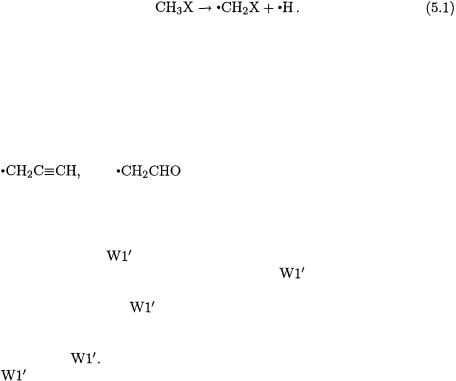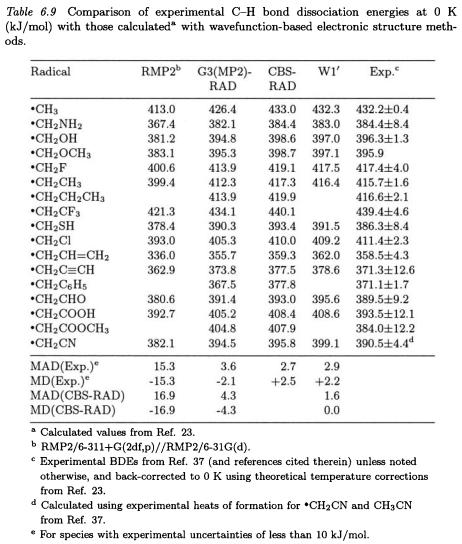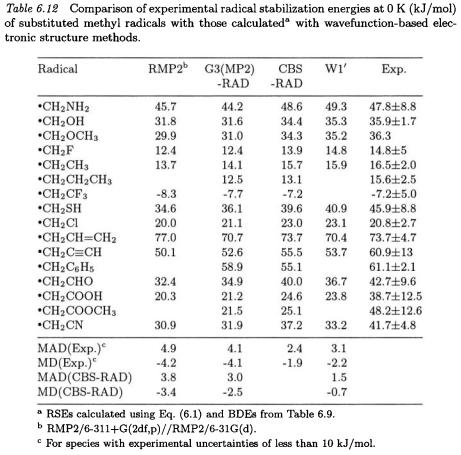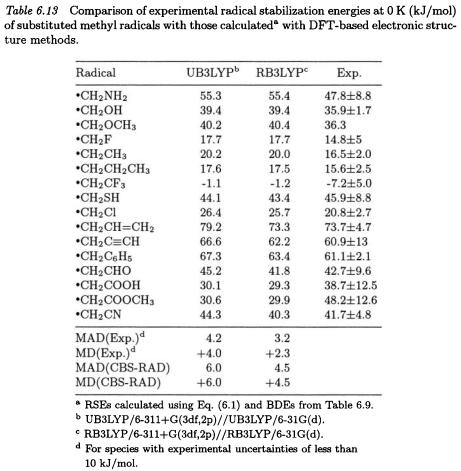
- •Table of Contents
- •Preface
- •Contributors
- •1. INTRODUCTION
- •2. HIERARCHIES OF AB INITIO THEORY
- •2.3. Computational Cost
- •3.2. The CCSD(T) Model
- •4.1. Electronic and Nuclear Contributions
- •4.2. Dependence on the AO Basis Set
- •5.2. Extrapolations from Principal Expansions
- •6. CALIBRATION OF THE EXTRAPOLATION TECHNIQUE
- •6.2. Total Electronic Energy
- •6.3. Core Contributions to AEs
- •7. MOLECULAR VIBRATIONAL CORRECTIONS
- •8. RELATIVISTIC CONTRIBUTIONS
- •9. CALCULATION OF ATOMIZATION ENERGIES
- •10. CONCLUSIONS AND PERSPECTIVES
- •2. STEPS IN THE W1 AND W2 THEORIES, AND THEIR JUSTIFICATION
- •2.1. Reference Geometry
- •2.2. The SCF Component of TAE
- •2.3. The CCSD Valence Correlation Component of TAE
- •2.4. Connected Triple Excitations: the (T) Valence Correlation Component of TAE
- •2.6. Scalar Relativistic Correction
- •3. PERFORMANCE OF W1 AND W2 THEORIES
- •3.2. Electron Affinities (the G2/97 Set)
- •3.4. Heats of Formation (the G2/97 Set)
- •3.5. Proton Affinities
- •4. VARIANTS AND SIMPLIFICATIONS
- •4.2. W1h and W2h Theories
- •4.5. W1c Theory
- •4.6. Detecting Problems
- •5. EXAMPLE APPLICATIONS
- •5.1. Heats of Vaporization of Boron and Silicon
- •5.2. Validating DFT Methods for Transition States: the Walden Inversion
- •5.3. Benzene as a ”Stress Test” of the Method
- •6. CONCLUSIONS AND PROSPECTS
- •1. INTRODUCTION
- •2. THE G3/99 TEST SET
- •4. G3S THEORY
- •5. G3X THEORY
- •6. DENSITY FUNCTIONAL THEORY
- •7. CONCLUDING REMARKS
- •1. INTRODUCTION
- •2. PAIR NATURAL ORBITAL EXTRAPOLATIONS
- •3. CURRENT CBS MODELS
- •4. TRANSITION STATES
- •5. EXPLICIT FUNCTIONS OF THE INTERELECTRON DISTANCE
- •7. NEW DEVELOPMENTS
- •7.1. The SCF Limit
- •7.2. The CBS Limit for the MP2 Correlation Energy
- •7.4. Total Energies
- •8. ENZYME KINETICS AND MECHANISM
- •9. SUMMARY
- •1. INTRODUCTION
- •2. ELECTRON PROPAGATOR CONCEPTS
- •3. AN ECONOMICAL APPROXIMATION: P3
- •4. OTHER DIAGONAL APPROXIMATIONS
- •5. NONDIAGONAL APPROXIMATIONS
- •7. P3 TEST RESULTS
- •7.1. Atomic Ionization Energies
- •7.2. Molecular Species
- •8. CONCLUSIONS AND PROSPECTUS
- •1. INTRODUCTION
- •2. THEORETICAL PROCEDURES
- •3. GEOMETRIES
- •4. HEATS OF FORMATION
- •5. BOND DISSOCIATION ENERGIES
- •6. RADICAL STABILIZATION ENERGIES
- •7. REACTION BARRIERS
- •8. REACTION ENTHALPIES
- •9. CONCLUDING REMARKS
- •1. INTRODUCTION
- •2. HOMOLEPTIC CARBONYL COMPLEXES
- •4. IRON CARBONYL COMPLEXES
- •5. GROUP-10 CARBONYL COMPLEXES
- •7. NOBLE GAS COMPLEXES
- •8. TRANSITION METAL CARBENE AND CARBYNE COMPLEXES
- •12. TRANSITION METAL METHYL AND PHENYL COMPOUNDS
- •13. TRANSITION METAL NITRIDO AND PHOSPHIDO COMPLEXES
- •15. MAIN GROUP COMPLEXES OF BeO
- •16. CONCLUSION
- •1. INTRODUCTION
- •2. THEORETICAL BACKGROUND
- •3. SPECIFIC CONVENTIONS
- •4. STATISTICAL EVALUATIONS
- •5. DISCUSSION
- •Index

174 |
Chapter 6 |
In summary, all of the methods shown in Tables 6.6 - 6.8 give good overall performance for the prediction of radical heats of formation (MADs of 2.1 - 4.5 kJ/mol). For species displaying significant spin contamination, methods based on a UMP2 reference geometry may give heats of formation for radicals that show larger-than-normal deviations from experiment. The RAD procedures give improved performance in such circumstances.
5.BOND DISSOCIATION ENERGIES
Bond dissociation energies (BDEs) provide a measure of both the reactivity of a compound (with respect to homolytic bond rupture) and the stability of the corresponding radical. There have been many theoretical investigations of BDEs for a wide variety of species [36]. In particular, the C–H BDE for a substituted methane is given by the enthalpy change for the reaction:
Bond dissociation energies for a selection of substituted methanes, calculated at a range of levels [23], are compared with experimental values [37] in Tables 6.9 and 6.10. Also listed are mean absolute deviations (MADs) and mean deviations (MDs) from experimental values [e.g. MAD(Exp.)] and from CBS-RAD [e.g. MD(CBS-RAD)].
The results in Table 6.9 show that the high-level  procedure generally produces close agreement with experiment, particularly for species with small error bars (< 5 kJ/mol). Several radicals (
procedure generally produces close agreement with experiment, particularly for species with small error bars (< 5 kJ/mol). Several radicals (
and |
) show slightly larger deviations (5.2 - 7.3 |
kJ/mol), but there is |
still agreement between theory and experiment |
to within the given experimental uncertainties. Cyanomethyl and carboxymethyl radicals show the largest deviations between theory and experiment (8.6 and 15.1 kJ/mol, respectively). The mean absolute de-
viation between |
and experiment is only 2.9 kJ/mol for the species |
|
with error bars of less than 10 kJ/mol. The |
level of theory is there- |
|
fore considered to be a reliable benchmark level for these systems. |
||
Unfortunately, |
is a computationally expensive procedure and |
|
therefore not easily accessible for the larger systems listed in Tables 6.9 and 6.10. The CBS-RAD procedure, however, demonstrates close agree-
ment with |
For example, the mean absolute deviation between |
the |
and CBS-RAD BDEs is 1.6 kJ/mol while the largest absolute |
de- |
|
viation is only 3.3 kJ/mol. Therefore, the CBS-RAD method represents a suitable secondary benchmark level for the assessment of the perfor-

Theoretical Thermochemistry of Radicals |
175 |
mance of other levels of theory in the prediction of BDEs of substituted methanes. The largest deviations between CBS-RAD and experiment occur for  (14.9 kJ/mol) and
(14.9 kJ/mol) and  (23.9 kJ/mol). It has been suggested [23] that experimental re-examination is warranted in these two instances.
(23.9 kJ/mol). It has been suggested [23] that experimental re-examination is warranted in these two instances.
Interestingly, with the exception of  all the other levels of theory in Tables 6.9 and 6.10 give BDEs that are smaller than CBS-RAD
all the other levels of theory in Tables 6.9 and 6.10 give BDEs that are smaller than CBS-RAD

176 |
Chapter 6 |
values, with the result that the magnitudes of MD(CBS-RAD) and MAD(CBS-RAD) are identical in all these cases.
The G3(MP2)-RAD approach most closely approximates its CBSRAD counterpart with an MAD of 4.3 kJ/mol. Significantly larger differences (MADs of 8.4 - 16.9 kJ/mol) are observed between CBS-RAD and the RB3LYP, UB3LYP and RMP2 approaches.
Clearly, the  and CBS-RAD methods give quite accurate BDEs for substituted methanes while the G3(MP2)-RAD and RB3LYP meth-
and CBS-RAD methods give quite accurate BDEs for substituted methanes while the G3(MP2)-RAD and RB3LYP meth-

Theoretical Thermochemistry of Radicals |
177 |
ods give acceptable performance. The absolute values of bond dissociation energies obtained from UB3LYP and RMP2 single-point energies are somewhat less satisfactory.
6.RADICAL STABILIZATION ENERGIES
Understanding the stabilizing or destabilizing influence of different substituents on radicals can be particularly important in controlling chemical processes that involve such radicals. Such effects have been studied extensively with electronic structure methods [36].
The radical stabilization energy (RSE) of a substituted methyl radical  is generally defined as the difference between the C–H bond dissociation energy in methane and the C–H BDE in the substituted methane
is generally defined as the difference between the C–H bond dissociation energy in methane and the C–H BDE in the substituted methane 
This quantity is equivalent to the enthalpy change for the isodesmic reaction:
Radicals with a positive RSE can therefore be considered stabilized relative to 
It is often assumed that there will be substantial cancellation of errors associated with the calculation of stabilization energies via reactions such as (6.2). However, this is not always the case. In particular, it has recently been shown [21, 34] that stabilization energies calculated for the cyanomethyl and cyanovinyl radicals show large variation with level of theory. For these situations, methods such as UMP2 perform very poorly because errors associated with spin contamination in the reactant and product radicals are very different and do not cancel.
Representative radical stabilization energies for the cyanomethyl radical [23, 34, 38] are displayed in Table 6.11. It can be seen that the high-level compound methods all predict RSEs within the narrow range of 31.9 - 37.9 kJ/mol. These values are reasonably close to but slightly lower than the value derived from recent experimental data of 41.7 4.8 kJ/mol (suggesting that the experimental value may be slightly overestimated). On the other hand, the UMP2/6-311+G(3df,2p) approach gives the wrong sign for the RSE (-5.7 kJ/mol), i.e. it wrongly predicts a slight destabilizing effect for the cyano substituent. This problem arises because of the artificially high energy calculated within the UMP2 approximation for cyanomethyl radical due to spin contamination. Similar
4.8 kJ/mol (suggesting that the experimental value may be slightly overestimated). On the other hand, the UMP2/6-311+G(3df,2p) approach gives the wrong sign for the RSE (-5.7 kJ/mol), i.e. it wrongly predicts a slight destabilizing effect for the cyano substituent. This problem arises because of the artificially high energy calculated within the UMP2 approximation for cyanomethyl radical due to spin contamination. Similar

178 |
Chapter 6 |
shortcomings are observed (but to a lesser extent) at the UMP4 (8.8 kJ/mol) and PMP2 (22.2 kJ/mol) levels of theory. Methods such as RMP2, UQCISD, UQCISD(T), UCCSD(T) and URCCSD(T) all perform reasonably well for the RSE of cyanomethyl radical.
RSEs for a broader selection of substituted methyl radicals, as well as MADs and MDs from experiment and CBS-RAD values, are presented in Tables 6.12 and 6.13. We noted in the previous section that our highest-level procedure, namely  gives accurate BDEs, and this observation carries over to the RSEs calculated at this level. The MAD from experiment for the
gives accurate BDEs, and this observation carries over to the RSEs calculated at this level. The MAD from experiment for the  method is 3.1 kJ/mol. The
method is 3.1 kJ/mol. The  RSEs tend to be slightly lower than those determined from experimental data [MD(Exp.) of -2.2 kJ/mol].
RSEs tend to be slightly lower than those determined from experimental data [MD(Exp.) of -2.2 kJ/mol].
At the CBS-RAD level of theory, the MAD from experiment is only 2.4 kJ/mol. Here once again, the CBS-RAD procedure tends to give slightly lower RSEs than experiment [MD(Exp.) of -1.9 kJ/mol].

Theoretical Thermochemistry of Radicals |
179 |
The G3(MP2)-RAD level of theory is found to compare well in accuracy with its CBS-RAD counterpart [MAD(CBS-RAD) of 3.0 kJ/mol]. It can be seen from Table 6.12 that the G3(MP2)-RAD procedure systematically underestimates CBS-RAD stabilization energies [MD(CBSRAD) of -2.5 kJ/mol]. This appears to be due to the slightly larger deviation in the BDE for methane (6.6 kJ/mol) than for its substituted analogues (ca. 4.1 kJ/mol).
Due to a systematic cancellation of (the quite large) absolute errors in the BDEs, RMP2/6-311+G(2df,p) single-point calculations also perform quite acceptably in predicting RSEs [MAD(CBS-RAD) of 3.8 kJ/mol]. The slightly greater underestimation of the BDE for methane (20.0 kJ/mol) than for the substituted methanes (ca. 16.7 kJ/mol) leads

180 |
Chapter 6 |
to systematical underestimation of RSEs [MD(CBS-RAD) of -3.4 kJ/mol]. The RB3LYP/6-311+G(3df,2p) level of theory performs slightly less well [MAD(CBS-RAD) of 4.5 kJ/mol] than the RMP2 method for stabilization energies, while the UB3LYP/6-311+G(3df,2p) level shows the largest MAD (6.0 kJ/mol) from CBS-RAD. Interestingly, both RB3LYP and UB3LYP procedures tend to overestimate the CBS-RAD RSEs (MD(CBS-RAD) of +4.5 and +6.0 kJ/mol, respectively). This can be attributed to the fact that both levels underestimate the BDEs for the substituted methanes (ca. 8.7 and 14.4 kJ/mol) to a greater extent than for methane (4.2 and 8.4 kJ/mol, respectively).
